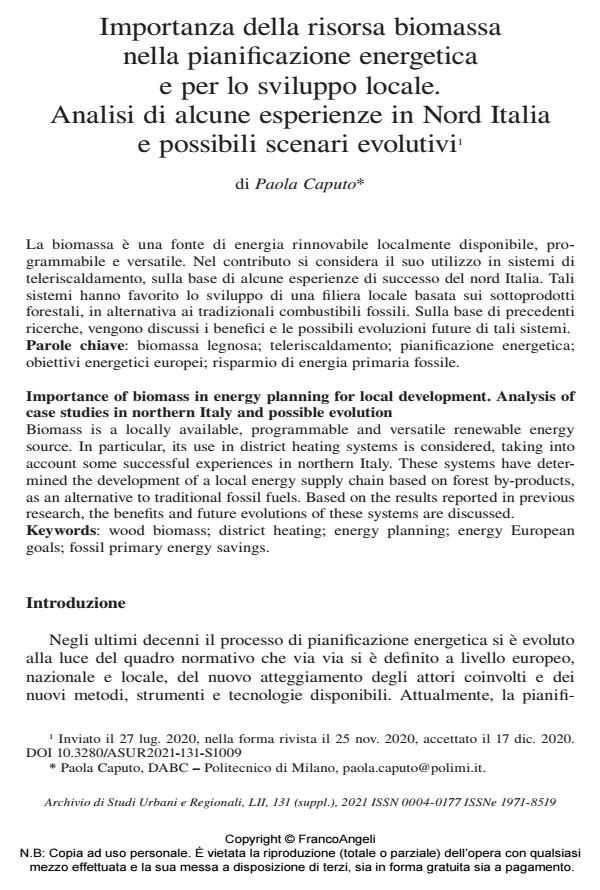Importanza della risorsa biomassa nella pianificazione energetica e per lo sviluppo locale. Analisi di alcune esperienze in Nord Italia e possibili scenari evolutivi
Titolo Rivista ARCHIVIO DI STUDI URBANI E REGIONALI
Autori/Curatori Paola Caputo
Anno di pubblicazione 2021 Fascicolo 2021/suppl. 131 Lingua Italiano
Numero pagine 19 P. 186-204 Dimensione file 149 KB
DOI 10.3280/ASUR2021-131-S1009
Il DOI è il codice a barre della proprietà intellettuale: per saperne di più
clicca qui
Qui sotto puoi vedere in anteprima la prima pagina di questo articolo.
Se questo articolo ti interessa, lo puoi acquistare (e scaricare in formato pdf) seguendo le facili indicazioni per acquistare il download credit. Acquista Download Credits per scaricare questo Articolo in formato PDF

FrancoAngeli è membro della Publishers International Linking Association, Inc (PILA)associazione indipendente e non profit per facilitare (attraverso i servizi tecnologici implementati da CrossRef.org) l’accesso degli studiosi ai contenuti digitali nelle pubblicazioni professionali e scientifiche
La biomassa è una fonte di energia rinnovabile localmente disponibile, programmabile e versatile. Nel contributo si considera il suo utilizzo in sistemi di teleriscaldamento, sulla ba-se di alcune esperienze di successo del nord Italia. Tali sistemi hanno favorito lo sviluppo di una filiera locale basata sui sottoprodotti forestali, in alternativa ai tradizionali combu-stibili fossili. Sulla base di precedenti ricerche, vengono discussi i benefici e le possibili evo-luzioni future di tali sistemi.;
Keywords:biomassa legnosa; teleriscaldamento; pianificazione energetica; obiettivi energetici europei; risparmio di energia primaria fossile.
- Aa.Vv. (2015). Biomasse legnose: Petrolio verde per il teleriscaldamento italiano. Milano: FIPER.
- Aa.Vv. (2018). Teleriscaldamento a biomassa: un investimento per il territorio. Milano: FIPER.
- Aa.Vv. (2021). Report impianti teleriscaldamento a biomassa Fiper 2020. Milano: FIPER.
- Andric I., Fournier J., Lacarriere B., Le Corre O. and Ferrao P. (2018). The impact of global warming and building renovation measures on district heating system techno-economic parameters. Energy, 150: 926-937.
- Aste N., Buzzetti M. and Caputo P. (2015). District heating in Lombardy Region (Italy): Effects of supporting mechanisms. Sustainable Cities and Society, 14: 43-55.
- Aste N., Caputo P., Del Pero C., Ferla G., Huerto Cardenas H.E., Leonforte F. (2020). A renewable energy scenario for a new low carbon settlement in northern Italy: Biomass district heating coupled with heat pump and solar photovoltaic system. Energy, 206.
- Baldan D. e Palmieri L. (2015). Linee Guida per un’economia circolare nella manutenzione del verde. Padova: Cleup.
- Beccali M., Columba P., D’Alberti V. and Franzitta, V. (2009). Assessment of bioenergy potential in Sicily: A GIS-based support methodology. Biomass and Bioenergy, 33(1): 79-87.
- Caputo P. (2010). Impianti a biomassa. Dal riscaldamento alla trigenerazione. Milano: Edizioni Ambiente.
- Caputo P. (2020). The Role of Renewable Energy Sources in Green Planning of Cities and Communities. In: Dall’O’ G., ed., Green Planning for Cities and Communities. Cham: Springer Nature, 229-251.
- Caputo P., Ferla G. and Ferrari S. (2019). Evaluation of environmental and energy effects of biomass district heating by a wide survey based on operational conditions in Italy. Energy, 174: 1210-1218.
- Caputo P., Ferla G., Belliardi M. and Cereghetti N. (2021). District thermal systems: State of the art and promising evolutive scenarios. A focus on Italy and Switzerland. Sustainable Cities and Society, 65: 102579.
- Colmenar-Santos A., Rosales-Asensio E., Borge-Diez D. and Blanes-Peiró J.J. (2016). District heating and cogeneration in the EU-28: Current situation, potential and proposed energy strategy for its generalization. Renewable and Sustainable Energy Reviews, 62: 621-639.
- Faninger G. (2000). Combined solar-biomass district heating in Austria. Sol Energy, 69: 425-35. DOI: 10.1016/S0038-092X(00)00117-
- Ferla G., Caputo P., Colaninno N. and Morello E. (2020). Urban greenery management and energy planning: A GIS-based potential evaluation of pruning by-products for energy application for the city of Milan. Renewable Energy, 160: 185-195.
- Hansen K., Breyer C. and Lund H. (2019). Status and perspectives on 100% renewable energy systems. Energy, 15: 471-480.
- Mathiesen B.V., Bertelsen N., Schneider N.C.A., García L.S., Paardekooper S., Thellufsen J.Z. and Djørup S.R. (2019). Towards a decarbonised heating and cooling sector in Europe: Unlocking the potential of energy efficiency and district energy. Aalborg: Aalborg Universitet.
- Pampuri L., Belliardi M., Bettini A., Cereghetti N., Curto I., Caputo P. (2019). A method for mapping areas potentially suitable for district heating systems. An application to Canton Ticino (Switzerland). Energy, 189: 116297.
- Reijnders L. (2006). Conditions for the sustainability of biomass-based fuel use. Energy Policy, 34(7): 863-876.
- Soltero V.M., Chacartegui R., Ortiz C., Lizana J. and Quirosa G. (2018). Biomass District Heating Systems Based on Agriculture Residues. Applied Sciences, 8(4): 476.
- Springer T.L. (2012). Biomass yield from an urban landscape. Biomass and Bioenergy, 37: 82-87.
- Stirpe F. (2009). Analisi quali-quantitativa dei residui vegetali prodotti dalla manutenzione del verde urbano di Roma. -- Testo disponibile al sito: http://dspace.unitus.it/bitstream/2067/1246/1/fstirpe_tesid.
Paola Caputo, Importanza della risorsa biomassa nella pianificazione energetica e per lo sviluppo locale. Analisi di alcune esperienze in Nord Italia e possibili scenari evolutivi in "ARCHIVIO DI STUDI URBANI E REGIONALI" suppl. 131/2021, pp 186-204, DOI: 10.3280/ASUR2021-131-S1009